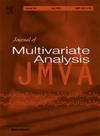Data depth functions for non-standard data by use of formal concept analysis
IF 1.4
3区 数学
Q2 STATISTICS & PROBABILITY
引用次数: 0
Abstract
In this article we introduce a notion of depth functions for data types that are not given in standard statistical data formats. We focus on data that cannot be represented by one specific data structure, such as normed vector spaces. This covers a wide range of different data types, which we refer to as non-standard data. Depth functions have been studied intensively for normed vector spaces. However, a discussion of depth functions for non-standard data is lacking. In this article, we address this gap by using formal concept analysis to obtain a unified data representation. Building on this representation, we then define depth functions for non-standard data. Furthermore, we provide a systematic basis by introducing structural properties using the data representation provided by formal concept analysis. Finally, we embed the generalised Tukey depth into our concept of data depth and analyse it using the introduced structural properties. Thus, this article presents the mathematical formalisation of centrality and outlyingness for non-standard data and increases the number of spaces in which centrality can be discussed. In particular, we provide a basis for defining further depth functions and statistical inference methods for non-standard data.
利用形式概念分析实现非标准数据的数据深度函数
在本文中,我们为标准统计数据格式中未给出的数据类型引入了深度函数的概念。我们将重点放在无法用一种特定数据结构表示的数据上,例如规范向量空间。这涵盖了各种不同的数据类型,我们称之为非标准数据。对于规范向量空间,深度函数已经得到了深入研究。然而,对于非标准数据的深度函数却缺乏讨论。在本文中,我们通过使用形式概念分析来获得统一的数据表示,从而弥补了这一空白。在此表示法的基础上,我们定义了非标准数据的深度函数。此外,我们还利用形式概念分析提供的数据表示引入了结构属性,从而提供了一个系统化的基础。最后,我们将广义图基深度嵌入到我们的数据深度概念中,并利用引入的结构属性对其进行分析。因此,本文提出了非标准数据的中心性和离散性的数学形式化,并增加了可讨论中心性的空间数量。特别是,我们为进一步定义非标准数据的深度函数和统计推断方法提供了基础。
本文章由计算机程序翻译,如有差异,请以英文原文为准。
求助全文
约1分钟内获得全文
求助全文
来源期刊

Journal of Multivariate Analysis
数学-统计学与概率论
CiteScore
2.40
自引率
25.00%
发文量
108
审稿时长
74 days
期刊介绍:
Founded in 1971, the Journal of Multivariate Analysis (JMVA) is the central venue for the publication of new, relevant methodology and particularly innovative applications pertaining to the analysis and interpretation of multidimensional data.
The journal welcomes contributions to all aspects of multivariate data analysis and modeling, including cluster analysis, discriminant analysis, factor analysis, and multidimensional continuous or discrete distribution theory. Topics of current interest include, but are not limited to, inferential aspects of
Copula modeling
Functional data analysis
Graphical modeling
High-dimensional data analysis
Image analysis
Multivariate extreme-value theory
Sparse modeling
Spatial statistics.
 求助内容:
求助内容: 应助结果提醒方式:
应助结果提醒方式:


